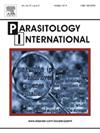Calicotyle confusa n. sp. (Monogenea: Monocotylidae) from Okamejei boesemani (Elasmobranchii) off Vietnam
IF 1.5
4区 医学
Q3 PARASITOLOGY
引用次数: 0
Abstract
Monogeneans of the genus Calicotyle Diesing, 1850 were found in the cloaca of the Arafura skate Okamejei boesemani (Ishihara, 1987) from the coastal waters of Vietnam. A partial 28S rDNA sequence (822 bp) was obtained from the collected specimen and deposited in GenBank (accession number PP868284). Comparative analysis with the available 28S rDNA sequences of Calicotyle spp. in the NCBI database revealed the smallest p-distances with the C. kroyeri Diesing, 1850 species complex. However, the genetic distance between the obtained sequence and C. kroyeri (AF279746) from its type host, Amblyraja radiata (Donovan, 1808), and type locality (the North Sea), was 4.2 %, while distances from all C. kroyeri isolates from the Atlantic Ocean (AF279744 – AF279747) ranged from 4.2 to 5.9 %. Based on these results, a new species, C. confusa n. sp., was proposed. Morphologically, C. confusa n. sp. exhibits smaller, albeit overlapping, dimensions compared to C. kroyeri specimens from the North Atlantic. However, no significant differences were observed between the two species in taxonomically important characters. Further morphological studies of C. kroyeri from its type host, as well as from other hosts and regions, are required to identify potential diagnostic characters distinguishing it from C. confusa n. sp.
越南河蟹目萼子叶花(单属:单子叶科)。
在越南沿海的Arafura skate Okamejei boesemani (Ishihara, 1987)的排水沟中发现了Calicotyle Diesing, 1850属单系植物。从采集的标本中获得28S rDNA部分序列(822 bp),并存入GenBank(登录号PP868284)。与NCBI数据库中Calicotyle spp. 28S rDNA序列进行比较,发现与C. kroyeri Diesing, 1850种复合体的p距离最小。然而,所获得的序列与C. kroyeri (AF279746)来自其型宿主Amblyraja radiata (Donovan, 1808)和型地(北海)的遗传距离为4.2 %,而与来自大西洋(AF279744 - AF279747)的所有C. kroyeri分离株的遗传距离为4.2 ~ 5.9 %。在此基础上,提出了一个新种——C. confusus n. sp.。在形态学上,与北大西洋的C. kroyeri标本相比,C. confusus n. sp.表现出较小的尺寸,尽管有重叠。然而,在重要的分类学性状上,两种间无显著差异。进一步的形态学研究需要从其类型寄主,以及其他寄主和地区,确定潜在的诊断特征,以区分其与C. confusus n. sp。
本文章由计算机程序翻译,如有差异,请以英文原文为准。
求助全文
约1分钟内获得全文
求助全文
来源期刊

Parasitology International
医学-寄生虫学
CiteScore
4.00
自引率
10.50%
发文量
140
审稿时长
61 days
期刊介绍:
Parasitology International provides a medium for rapid, carefully reviewed publications in the field of human and animal parasitology. Original papers, rapid communications, and original case reports from all geographical areas and covering all parasitological disciplines, including structure, immunology, cell biology, biochemistry, molecular biology, and systematics, may be submitted. Reviews on recent developments are invited regularly, but suggestions in this respect are welcome. Letters to the Editor commenting on any aspect of the Journal are also welcome.
 求助内容:
求助内容: 应助结果提醒方式:
应助结果提醒方式:


